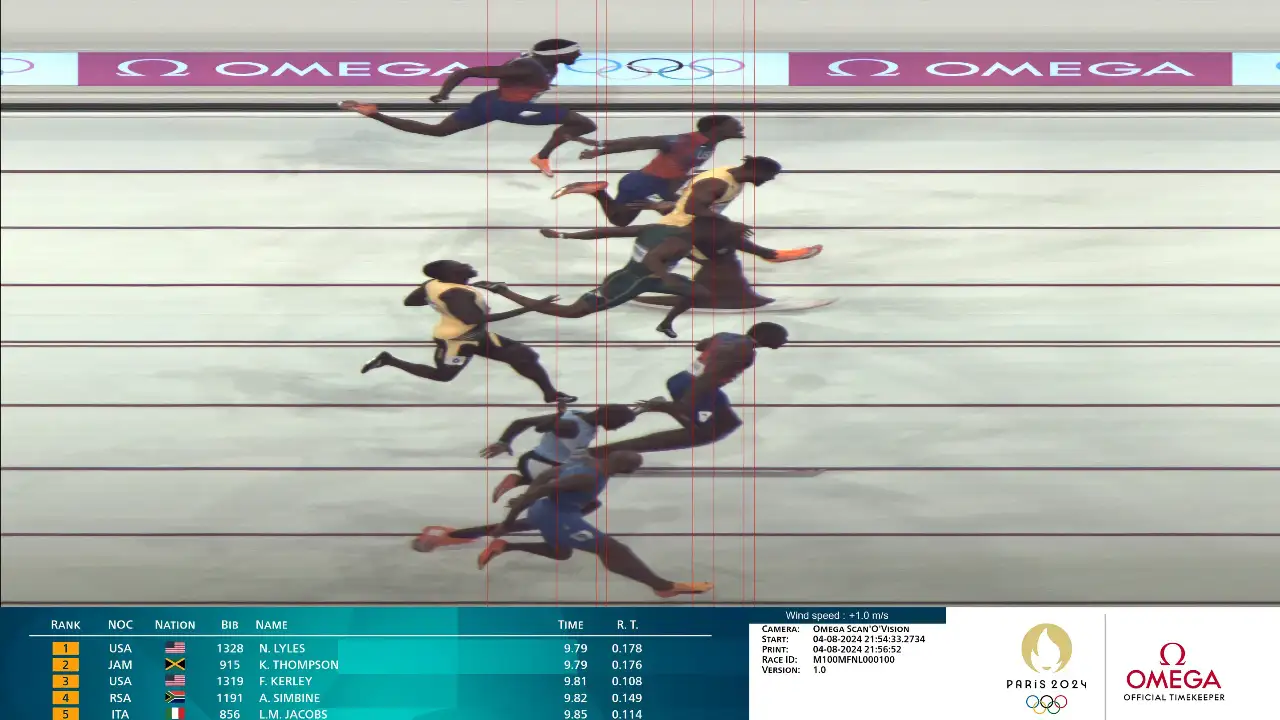
A new camera from official Olympics timing service Omega runs at 40,000 frames per second and is just what you need when athletes hit the timing beam inseparable to the naked eye.
We have seen some impressive photo finishes at Paris 2024, with athletes separated by a hair’s breadth when they cross the timing beam at numerous track and field events. It’s still difficult even looking at the photo with the naked eye to separate Josh Kerr’s silver from Yared Nuguse’s bronze in the 1500m final; there was 100th of a second between them. And then there was the 100 metre men’s final, the fastest race in history, a race so tight that numerous commentators called it wrong because they just hadn’t seen the USA’s Noah Lyles in lane 7 run a personal best and beat Jamaica’s Kishane Thompson on the line by five thousandths of a second.
Lyles hit 27.09 miles per hour (43.6 kph) at one point in his run, and separating him from Thompson was Omega’s Scan‘O’Vision ULTIMATE photo finish camera, which can record 40,000 digital images per second. This is being used at the Olympics for the first time, replacing the previous generation device, the Scan‘O’Vision MYRIA, which was only able to record 10,000 fps.

The Scan‘O’Vision ULTIMATE photo finish camera
The Scan'O'Vision is a line-scan camera. This does exactly what it says on the tin; the camera's sensor consisting of a single column of pixels that repeatedly scans the finish line, building a composite image over time rather than taking a traditional photograph. Each slice represents a specific moment while theresulting image shows a continuous view of the finish. Athletes appear stretched or compressed based on their speed.
Of course it’s not the only camera Omega’s using at the Olympics; indeed at the Velodrome it needs to separate bike wheels thrown at the line that are going considerably faster even than Lyles and Thompson, touching 46 mph (74 kph). According to Axios, Omega has brought 350 tons of gear to the Olympics, including a whopping 124 miles (200 kilometers) of cable and 550 timekeepers.
It’s not just about the timing either. Omega’s Computer Vision technology has been used to track the exact motion of athletes in numerous sports, from beach volleyball to diving, helping to create 3D versions of the replays to help better understand what’s just taken place. This enables it to add to the blizzard of stats that broadcasters like to hire at the viewer (and coaches like to analyse afterwards), covering everything from airtime and speed in the diving to distance behind the line in the long-jump and above the bar in the pole-vault.
A Brief History of Timing

How it used to be...An operator smashed the buttons at the bottom to stop the stopwatches
1932: Omega became the official time-keeper of the Olympic Games
1948: First use of a photoelectric cell for timing
1952: New electronics enabled times to be measured in 100ths of a second
1964: The Omegascope allowed realtime timing to be displayed on TV screens
1968: Touchpad timing triggers debuted in swimming pools
1992: The first Scan-‘O’-Vision was used to take timing down to 1000ths in speed skating
2010: The Electronic Start System replaced the traditional starting pistol, making detecting false starts easier and giving athletes the signal at the same time via speakers positioned behind each racer
tl;dr
- Omega, the official Olympics timing service, has introduced a new camera called Scan‘O’Vision ULTIMATE, capable of capturing 40,000 frames per second.
- This advanced camera has been crucial in capturing photo finishes in track and field events, such as the 1500m final and the 100-meter men's final, where athletes were separated by incredibly small margins.
- Along with the photo finishes, Omega has utilized Computer Vision technology to track athletes' motions in various sports, aiding in the creation of 3D replays and providing detailed statistics for viewers and coaches.
- Omega has brought an extensive amount of gear to the Olympics, including 350 tons of equipment and 124 miles of cable, showcasing the scale of their operations.

Men's 100m Final, Rome 1960: One of the first major events to be decided by electronic timing
Tags: Technology


Comments